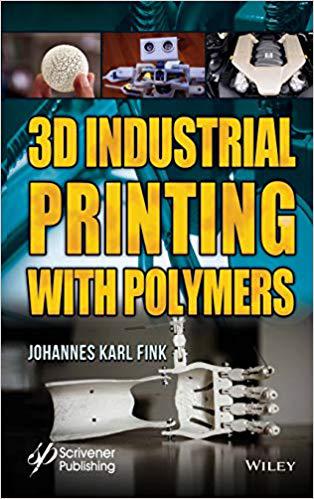图书简介
3D industrial printing has become mainstream in manufacturing. This unique book is the first to focus on polymers as the printing material. The scientific literature with respect to 3D printing is collated in this monograph. The book opens with a chapter on foundational issues such and presents a broad overview of 3D printing procedures and the materials used therein. In particular, the methods of 3d printing are discussed and the polymers and composites used for 3d printing are detailed. The book details the main fields of applications areas which include electric and magnetic uses, medical applications, and pharmaceutical applications. Electric and magnetic uses include electronic materials, actuators, piezoelectric materials, antennas, batteries and fuel cells. Medical applications are organ manufacturing, bone repair materials, drug-eluting coronary stents, and dental applications. The pharmaceutical applications are composite tablets, transdermal drug delivery, and patient-specific liquid capsules. A special chapter deals with the growing aircraft and automotive uses for 3D printing, such as with manufacturing of aircraft parts and aircraft cabins. In the field of cars, 3D printing is gaining importance for automotive parts (brake components, drives), for the fabrication of automotive repair systems, and even 3D printed vehicles.
Preface xi 1 Methods of 3D Printing 1 1.1 History 2 1.1.1 Recently Developed Materials for 3D Printing 5 1.1.2 Shrinkage Compensation 5 1.2 Basic Principles 9 1.2.1 4D Printing 10 1.3 Uses and Applications 10 1.3.1 Heat Exchangers 10 1.3.2 3D Plastic Model 10 1.3.3 Gradient Refractive Index Lenses 11 1.3.4 Photoformable Composition 13 1.3.5 Comb Polymers 13 1.3.6 Post-Processing Infiltration 14 1.3.7 Sensors and Biosensors 16 1.4 Magnetic Separation 19 1.5 Rapid Prototyping 20 1.5.1 Variants of Rapid Prototyping 22 1.5.2 3D Microfluidic Channel Systems 24 1.5.3 Aluminum and Magnesium Cores 24 1.5.4 Cellular Composites 25 1.5.5 Powder Compositions 25 1.5.6 Organopolysiloxane Compositions 26 1.5.7 Thermoplastic Powder Material 29 1.5.8 Plasticizer-Assisted Sintering 29 1.5.9 Radiation-Curable Resin Composition 29 1.6 Solution Mask Liquid Lithography 33 1.7 Vat Polymerization 34 1.7.1 Poly(dimethyl siloxane)-Based Photopolymer 35 1.8 Hot Lithography 37 1.9 Ambient Reactive Extrusion 37 1.10 Micromanufacturing Engineering 38 1.11 Analytical Uses 38 1.11.1 Gas Sensors 38 1.12 Chemical Engineering 39 1.12.1 Gas Separation 41 1.12.2 Hierarchical Monoliths for Carbon Monoxide Methanation 42 1.13 Rotating Spinnerets 43 1.14 Objects with Surface Microstructures 45 1.15 Lightweight Cellular Composites 46 1.16 Textiles 47 1.16.1 3D Printed Polymers Combined with Textiles 47 1.16.2 Mechanical and Electrical Contacting 47 1.16.3 Soft Electronic Textiles 48 1.16.4 4D Textiles 50 References 51 2 Polymers 61 2.1 Polymer Matrix Composites 61 2.1.1 Biocomposite Filaments 63 2.1.2 Nanocomposites 64 2.1.3 Nanowires 65 2.1.4 Fiber Reinforced Polymers 66 2.1.5 Carbon Fiber Polymer Composites 67 2.1.6 FDM Printing 70 2.1.7 Powder Bed and Inkjet Head 3D Printing 73 2.1.8 Stereolithography 73 2.1.9 Selective Laser Sintering 74 2.2 Sequential Interpenetrating Polymer Network 74 2.3 3D Printable Diamond Polymer Composite 75 2.4 Adhesives for 3D Printing 76 2.5 Voronoi-Based Composite Structures 77 2.6 Graphene Oxide Reinforced Complex Architectures 78 2.7 Multiwalled Carbon Nanotube Composites 79 2.8 Multifunctional Polymer Nanocomposites 81 2.9 Additive Manufacturing 83 2.9.1 Thermosetting Polymers 85 2.9.2 UV Curable Materials 85 2.9.3 (Meth)acrylate Monomers 88 2.9.4 Thiol-ene and Thiol-yne Systems 91 2.9.5 Epoxides 94 2.10 Visible Light-Curable and Visible Wavelength-Transparent Resin 95 2.11 Poly(ether ether ketone) 96 2.12 Lasers 97 2.13 Ultra-High MolecularWeight PE 97 2.14 Production of PP Polymer Powders 98 2.15 Acrylate-Based Compositions 99 2.15.1 Dimensionally Stable Acrylic Alloys 99 2.15.2 Oligoester Acrylates 100 2.16 Standards 101 2.16.1 Biomedical Applications 102 2.16.2 Color 102 2.17 Particle-Free Emulsions 103 2.18 Shape Memory Polymers 104 2.18.1 Synthesis with Stereolithography 105 2.18.2 Flexible Electronics 105 2.18.3 Magnetically Responsive Shape Memory Polymer 108 2.18.4 Sequential Self-Folding Structures 109 2.18.5 Multi-shape Active Composites 111 2.18.6 Radiation Sensitizers 112 2.18.7 Shape Memory Alloy Actuating Wire 112 2.18.8 Metal Electrode Fabrication 114 2.18.9 4D Printing 115 2.19 Water-Soluble Polymer 117 2.20 Water-Washable Resin Formulations 122 2.21 Extremely Viscous Materials 124 2.21.1 Tunable Ionic Control of Polymeric Films 124 2.22 Photopolymer Compositions 125 2.22.1 Mechanical Properties of UV Curable Materials 125 2.22.2 High-Performance Photopolymer with Low Volume Shrinkage 126 2.22.3 Dual InitiationWavelengths for 3D Printing 127 2.23 Crosslinked Polymers 129 2.24 Recycled Plastics 132 2.25 3D Printed Fiber Reinforced Portland Cement Paste 133 2.26 Polymer-Derived Ceramics 134 2.26.1 Photocurable Ceramic/Polymer Composites 135 2.26.2 Ceramic Matrix Composite Structures 137 2.26.3 Selective Laser Melting 145 2.26.4 Stereolithography Resin for Rapid Prototyping of Ceramics and Metals 146 References 147 3 Airplanes and Cars 159 3.1 Airplanes 160 3.1.1 Material Testing Standards 161 3.1.2 Lightweight Aircraft Components 161 3.1.3 Aircraft Spare Parts 161 3.1.4 Polymer Laser Sintering 162 3.1.5 Composites Part Production 163 3.1.6 DeployableWing Designs 163 3.1.7 Additive Manufacturing for Aerospace 164 3.1.8 Fiber Reinforced Polymeric Components 164 3.1.9 Manufacturing of Aircraft Parts 165 3.1.10 Multirotor Vehicles 166 3.1.11 Flame Retardant Aircraft Carpet 166 3.1.12 Aircraft Cabins 167 3.1.13 Additive Manufacturing of Solid Rocket Propellant Grains 167 3.1.14 High Temperature Heating System 167 3.1.15 Aerospace Propulsion Components 168 3.1.16 Antenna RF Boxes 169 3.1.17 Cyanate Ester Clay Nanocomposites 170 3.1.18 Bionic Lightweight Design 170 3.2 Cars 172 3.2.1 Laser Sintering 173 3.2.2 Automotive Repair Systems 174 3.2.3 Improving Aerodynamic Shapes 174 3.2.4 Common Automotive Applications 174 3.2.5 Thermomechanical Pulp Fibers 178 3.2.6 Polyamic Acid Salts 178 3.2.7 Recycled Tempered Glass from the Automotive Industry 179 References 180 4 Electric and Magnetic Uses 185 4.1 Electric Uses 185 4.1.1 Conductive Microstructures 185 4.1.2 Modular Supercapacitors 188 4.1.3 Active Electronic Materials 189 4.1.4 Piezoelectric Materials 192 4.1.5 Holographic Metasurface Antenna 195 4.1.6 Waveguide 195 4.1.7 Fuel Cell 196 4.1.8 Batteries 198 4.2 Magnetic Uses 203 4.2.1 Polymer-Based Permanent Magnets 203 4.2.2 Bonded Magnets 207 4.2.3 Strontium Ferrite 208 4.2.4 Soft-Magnetic Composite 208 4.2.5 Discontinuous Fiber Composites by 3D Magnetic Printing 209 References 211 5 Medical Applications 215 5.1 Basic Procedures 215 5.1.1 Image Acquisition 216 5.1.2 3D Printing 217 5.1.3 Microvalve-Based Bioprinting 219 5.2 3D Printed Organ Models for Surgical Applications 219 5.2.1 Organ Bioprinting 220 5.2.2 Materials 223 5.2.3 Liver 229 5.2.4 Heart 230 5.2.5 Cartilage 232 5.2.6 Bionic Ears 233 5.2.7 Skin 234 5.2.8 Scaffolds 235 5.2.9 Personalized Implants 238 5.2.10 Neural Tissue Models 238 5.3 Bioinks 241 5.3.1 Cytocompatible Bioink 243 5.3.2 Hydrogel Bioinks 246 5.3.3 Dentin-Derived Hydrogel Bioink 248 5.3.4 Decellularized Extracellular Matrix Materials 249 5.3.5 Silk-Based Bioink 251 5.3.6 Nanoengineered Ionic-Covalent Entanglement Bioinks 252 5.3.7 Living Skin Constructs 253 5.3.8 Cell-Laden Scaffolds 253 5.3.9 Patient-Specific Bioinks 255 5.4 Presurgical Simulation 256 5.5 Models with Integrated Soft Tactile Sensors 256 5.6 Dental Applications 256 5.6.1 Prosthetics 257 5.7 Fluidic Devices 259 5.8 3D Bioprinting of Tissues and Organs 259 5.8.1 3D Bioprinting Techniques 261 5.8.2 Pigmented Human Skin Constructs 262 5.8.3 Strategies for Tissue Engineering 263 5.8.4 Bone Tissue 264 5.8.5 Neuroregenerative Treatment 267 5.8.6 3D Tissues/Organs Combined with Microfluidics 267 5.8.7 3D Microfibrous Constructs 268 5.8.8 Biosynthetic Cellulose Implants 274 5.8.9 Polysaccharides 276 5.8.10 Corneal Transplants 277 5.8.11 Hydrogels from Collagen 278 5.8.12 Dissolved Cellulose 278 5.8.13 Hydrogels from Hyaluronic Acid and Methyl cellulose 279 5.8.14 Stem Cells 282 5.8.15 Autografts 283 5.8.16 Drug-Eluting Coronary Stents 284 5.9 Biomedical Devices 285 5.10 Soft Somatosensitive Actuators 286 References 287 6 Pharmaceutical Uses 303 6.1 Drug Release 303 6.1.1 Pharmaceutical 3D Printing 304 6.1.2 Pharmaceutically Acceptable Amorphous Polymers 304 6.1.3 Paracetamol Oral Tablets 305 6.1.4 Patient-Specific Liquid Capsules 306 6.1.5 Thermolabile Drugs 307 6.1.6 Composite Tablets 308 6.1.7 Transdermal Drug Delivery 309 6.1.8 Chip Platforms for Microarray 3D Bioprinting 309 References 314 Index 317 Acronyms 317 Chemicals 320 General Index 324
Trade Policy 买家须知
- 关于产品:
- ● 正版保障:本网站隶属于中国国际图书贸易集团公司,确保所有图书都是100%正版。
- ● 环保纸张:进口图书大多使用的都是环保轻型张,颜色偏黄,重量比较轻。
- ● 毛边版:即书翻页的地方,故意做成了参差不齐的样子,一般为精装版,更具收藏价值。
关于退换货:- 由于预订产品的特殊性,采购订单正式发订后,买方不得无故取消全部或部分产品的订购。
- 由于进口图书的特殊性,发生以下情况的,请直接拒收货物,由快递返回:
- ● 外包装破损/发错货/少发货/图书外观破损/图书配件不全(例如:光盘等)
并请在工作日通过电话400-008-1110联系我们。
- 签收后,如发生以下情况,请在签收后的5个工作日内联系客服办理退换货:
- ● 缺页/错页/错印/脱线
关于发货时间:- 一般情况下:
- ●【现货】 下单后48小时内由北京(库房)发出快递。
- ●【预订】【预售】下单后国外发货,到货时间预计5-8周左右,店铺默认中通快递,如需顺丰快递邮费到付。
- ● 需要开具发票的客户,发货时间可能在上述基础上再延后1-2个工作日(紧急发票需求,请联系010-68433105/3213);
- ● 如遇其他特殊原因,对发货时间有影响的,我们会第一时间在网站公告,敬请留意。
关于到货时间:- 由于进口图书入境入库后,都是委托第三方快递发货,所以我们只能保证在规定时间内发出,但无法为您保证确切的到货时间。
- ● 主要城市一般2-4天
- ● 偏远地区一般4-7天
关于接听咨询电话的时间:- 010-68433105/3213正常接听咨询电话的时间为:周一至周五上午8:30~下午5:00,周六、日及法定节假日休息,将无法接听来电,敬请谅解。
- 其它时间您也可以通过邮件联系我们:customer@readgo.cn,工作日会优先处理。
关于快递:- ● 已付款订单:主要由中通、宅急送负责派送,订单进度查询请拨打010-68433105/3213。
本书暂无推荐
本书暂无推荐
















